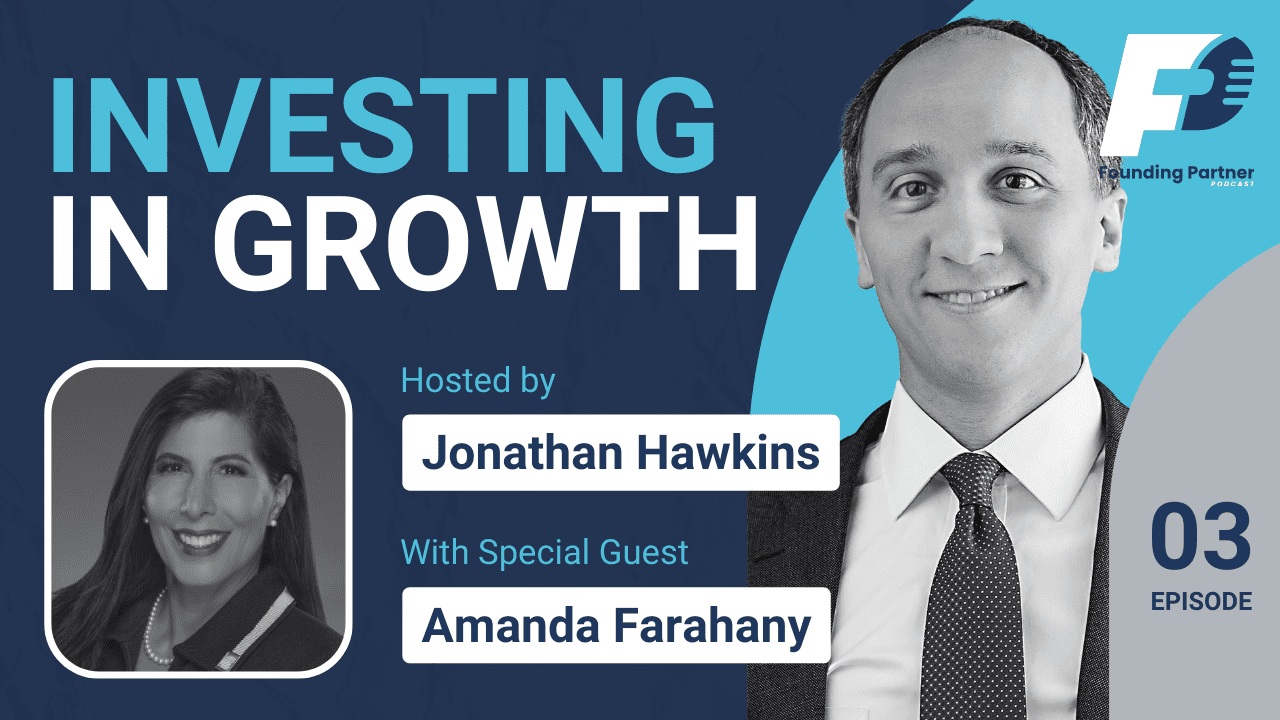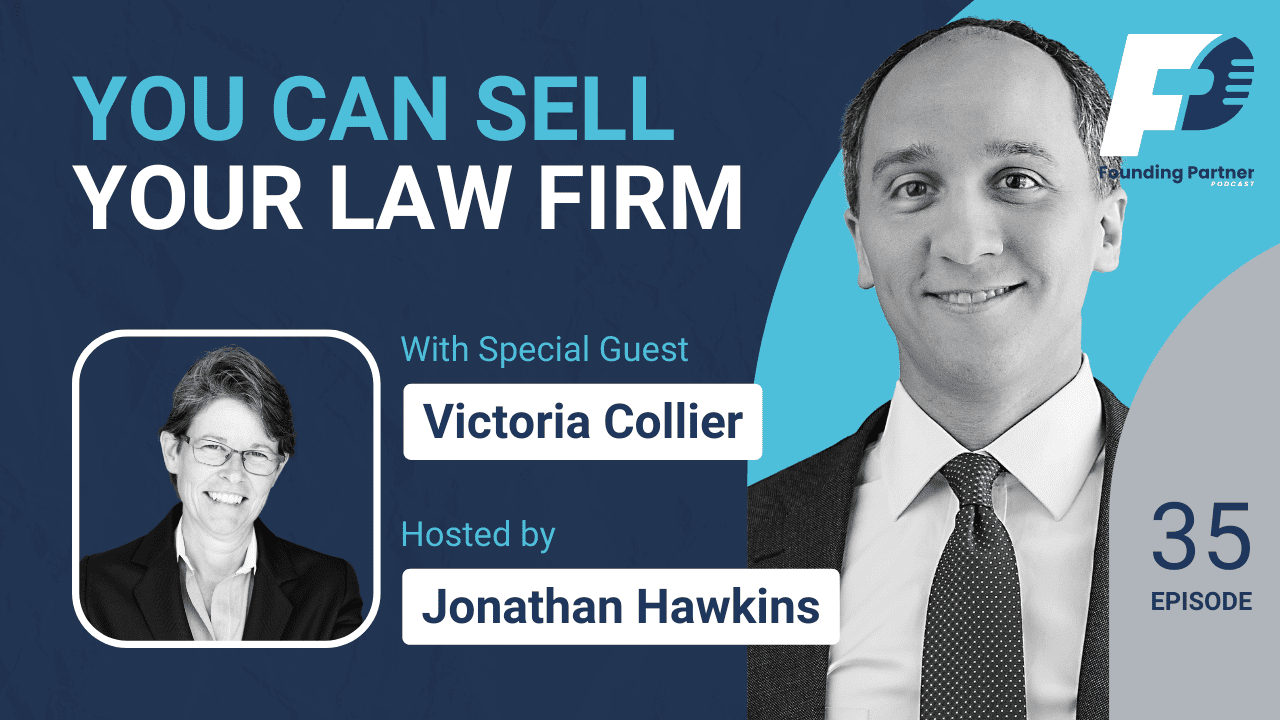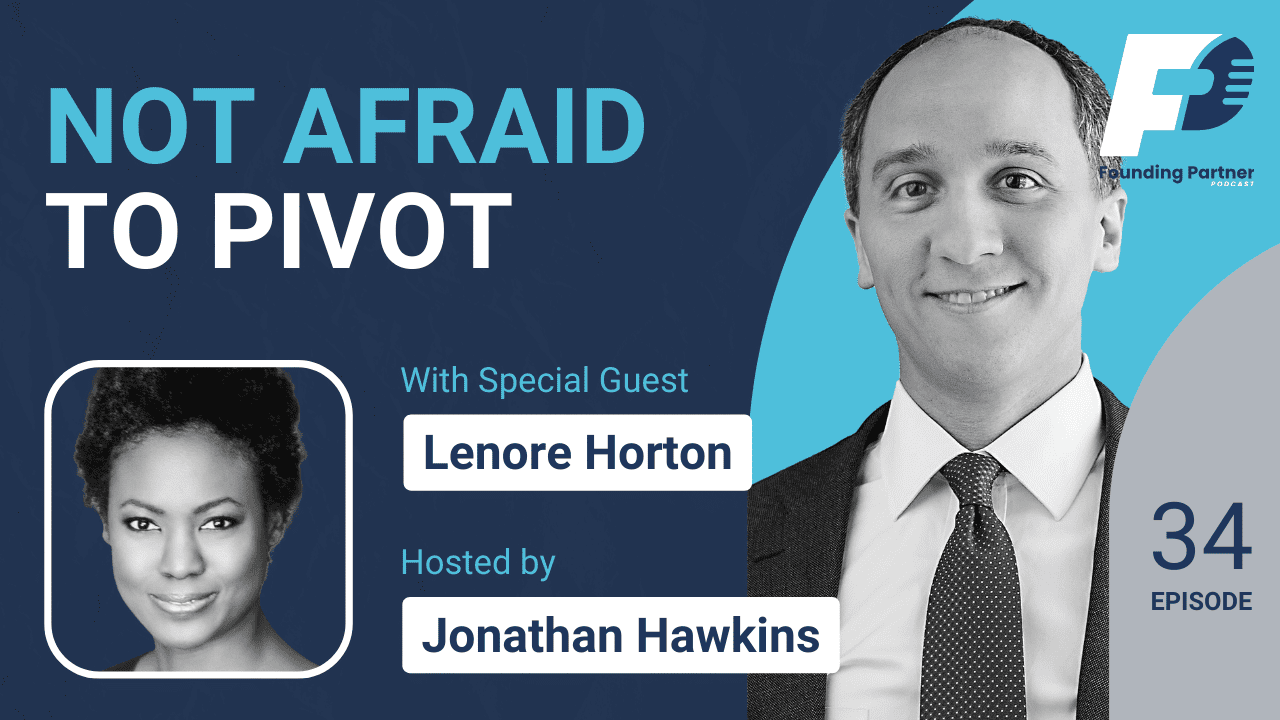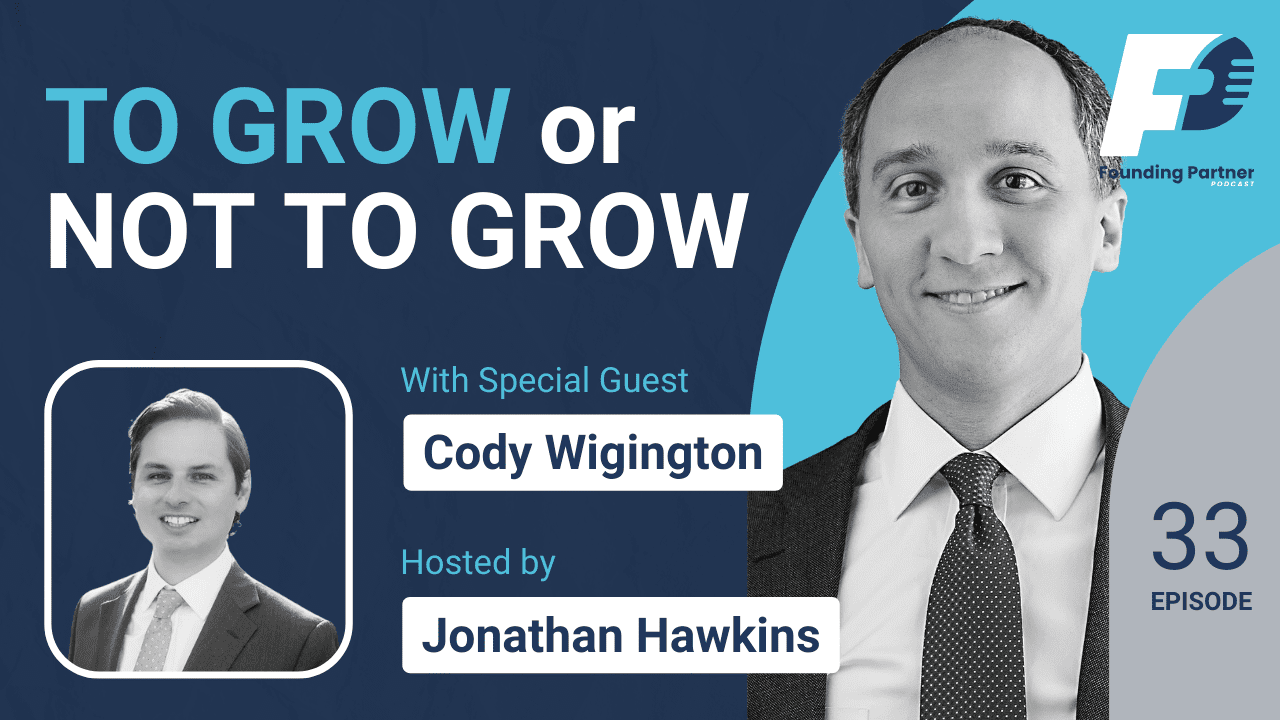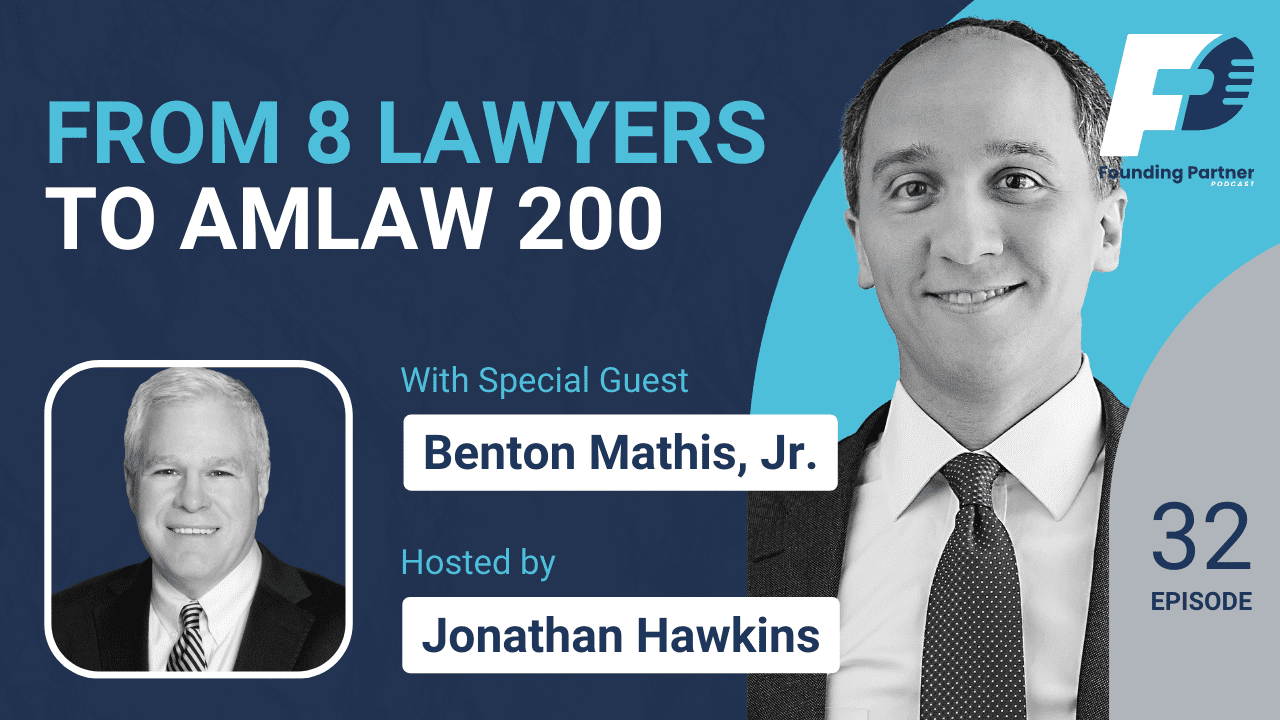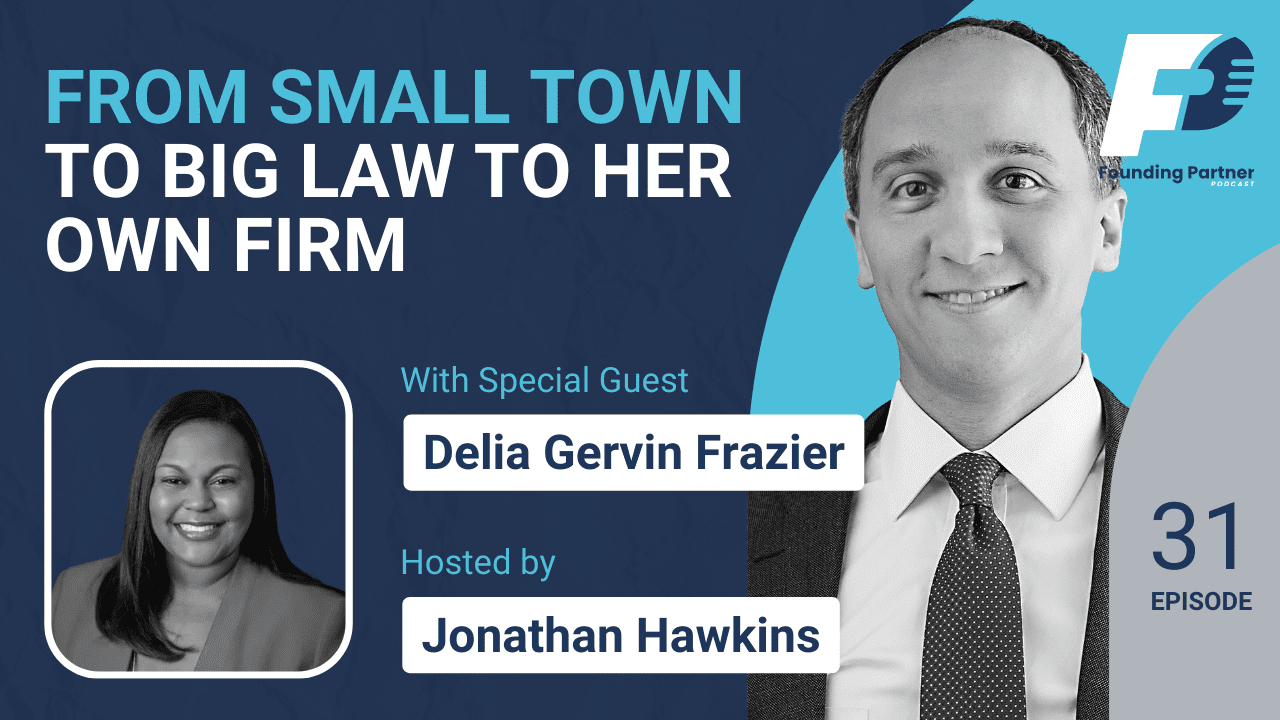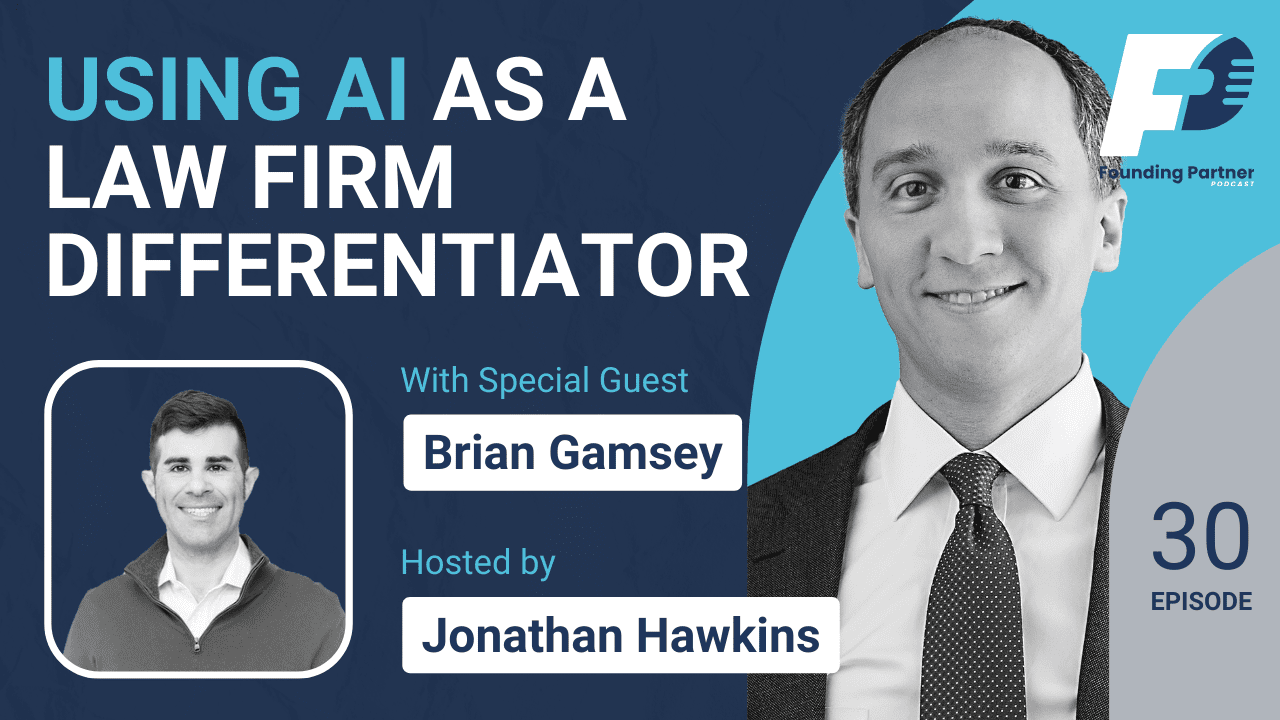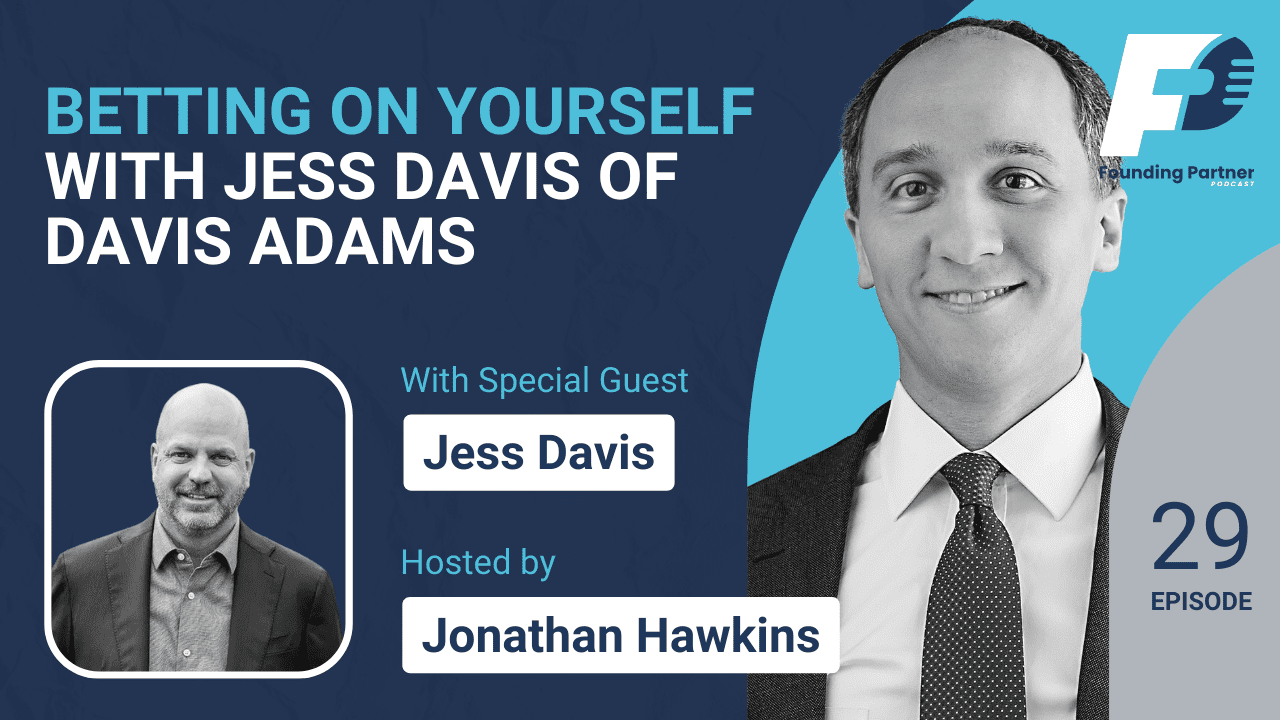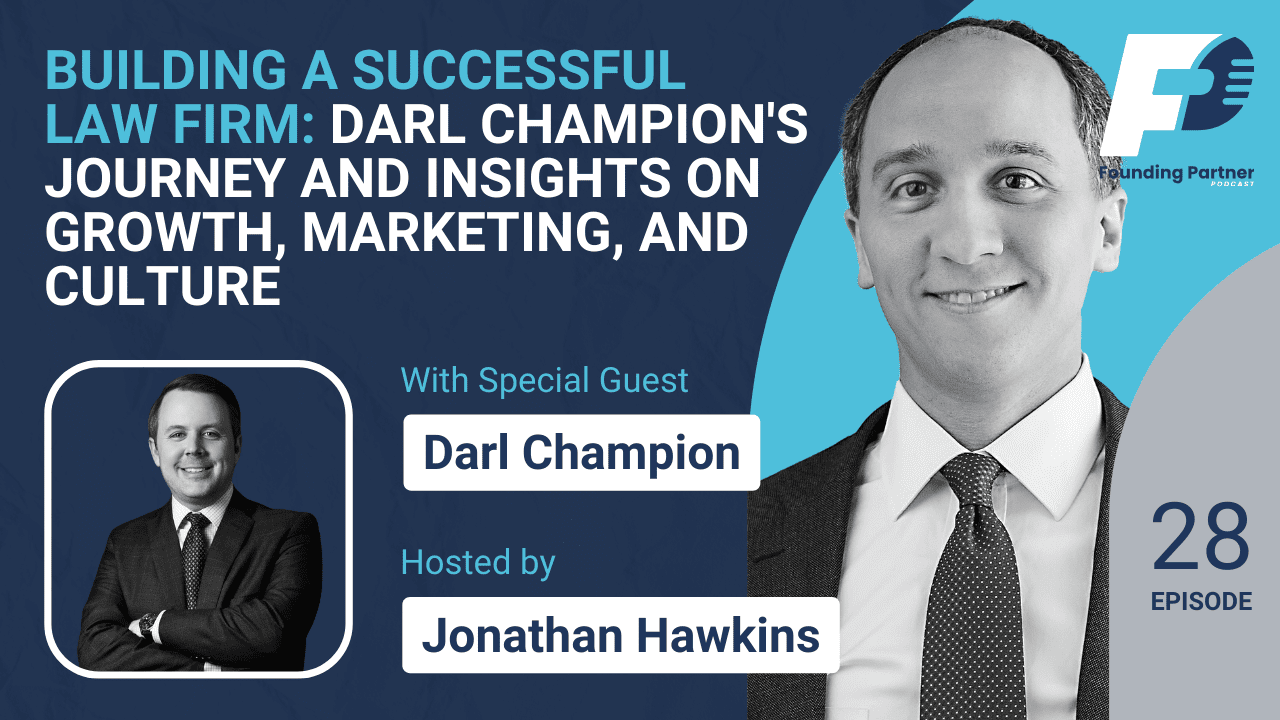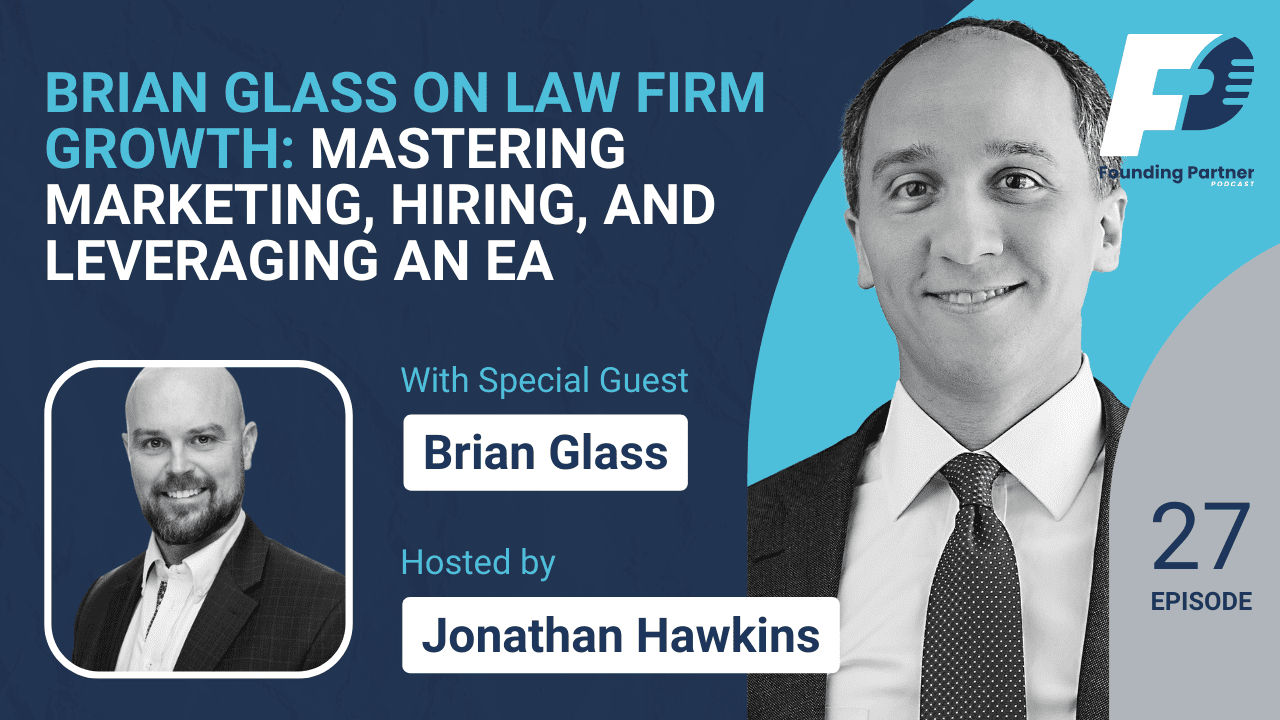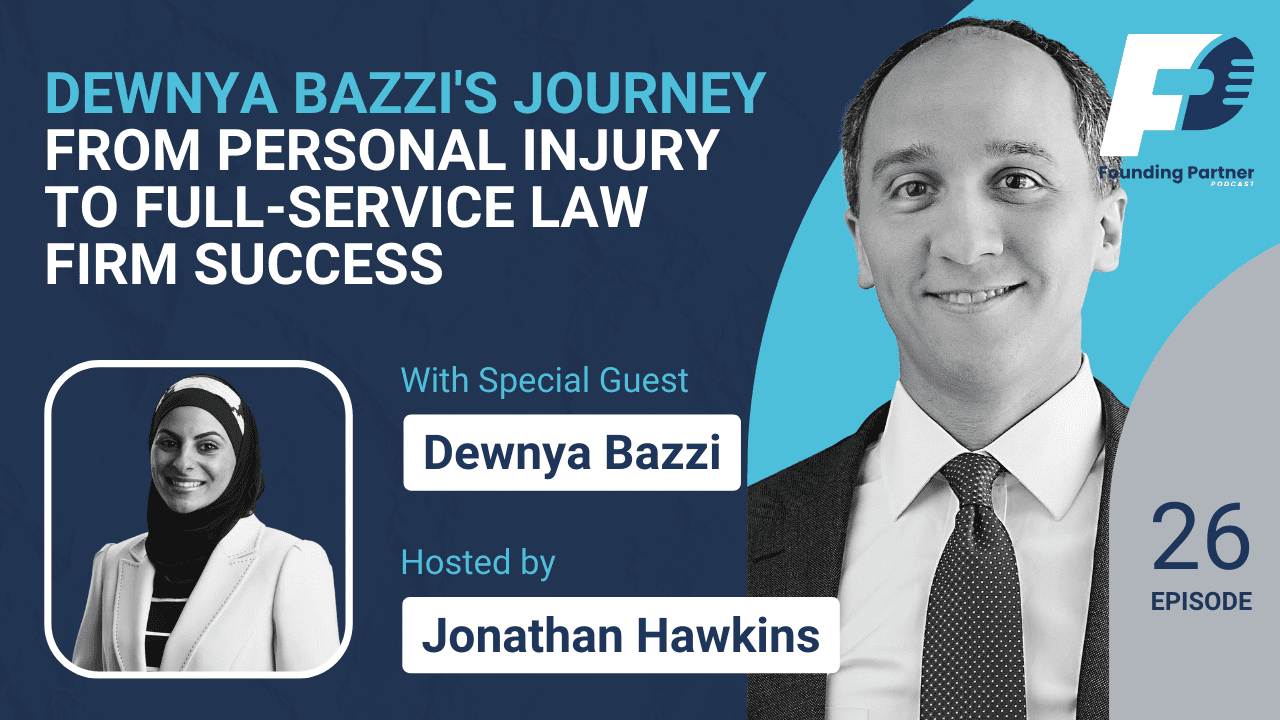Amanda Farahany: [00:00:00] So, in the kind of work that we do, there is more people who want our services than we can help, and that’s been one of the issues that I’ve had from the start of the firm is that there are more employees who need help and who have cases than there is the capacity to do it. And then there’s the problem with what we do, which is that we work on a contingency basis.
So it’s, a year or two years before the cases that we take turn into fees often. So it’s trying to balance those different things. What’s happened for me is that I’ve had a couple of really good cases that have turned into large fees and those fees… and at those points in time, I had to make a decision about whether I would take that money and invest in growth in the firm or just
take that money and keep it, and I decided that what I wanted to do is invest in growth in the firm.
[00:01:00]
Jonathan Hawkins: Welcome to Founding Partner Podcast. I’m Jonathan Hawkins, founder of Law Firm GC, a law firm that represents law firms and lawyers in business related matters. Excited to have our guest today, Amanda Farahaney. Amanda, why don’t you introduce yourself and tell us about your firm?
Amanda Farahany: Hi, I’m Amanda Farahani. I’m the managing partner of Barrett and Farahani. We are a plaintiff employment law firm. We do employment civil rights work. We’re headquartered out of Atlanta, and we are now in 10 states and the District of Columbia.
Jonathan Hawkins: Wow, 10 states. That’s a lot. So how many attorneys do you have now?
Amanda Farahany: I think we are 25 attorneys right now.[00:02:00]
Jonathan Hawkins: And then what about employees? Non attorney and attorney
Amanda Farahany: Uh, 60 something total employees.
Jonathan Hawkins: Wow. That’s impressive. So how long ago did you start the firm?
Amanda Farahany: I started the firm 25 years ago in October. So I just celebrated the anniversary of my becoming a solo practitioner. So it was just me at that point. And then we became Barrett Affair Honey in 2001. So it’s been a while.
Jonathan Hawkins: So where were you before you started your firm?
Amanda Farahany: I was working at the Georgia Court of Appeals. So I actually never worked for a law firm. I was a summer associate, but I actually never worked for a law firm full time.
Jonathan Hawkins: Did you know when you went to law school that you would be starting your own firm?
Amanda Farahany: I absolutely did not. No, I went to law school to be a international corporate lawyer. What I realized in law school is that I just like to travel. I don’t like contract work. I don’t like what international corporate work really is.[00:03:00] And so, no, I did not have any idea. In fact, I didn’t know that until I was.
Actually, about to start my 1st job, so I was coming out of the Georgia Court of appeals. I was interviewing from some different companies or different law firms and there was 1 firm. That was a international firm that was opening offices in Italy. And there was going to be some opportunities to do stuff with that.
And it sounded really cool, and I realized I didn’t want it and so I. I started to really think through what is it that I wanted and I realized I just, I didn’t want to work for somebody else. And so I decided to start my own law firm and now, 25 years later, same firm, never had a break.
Jonathan Hawkins: So did you have experience with employment discrimination? So let’s back up. You do plaintiff employment work, correct? Is it only, okay. So did you have experience with that before? And if not, how did you know, did the firm start out that way? And how did you get there?
Amanda Farahany: [00:04:00] so my only, my only experience with employment discrimination was my own. So, no, I did not have any experience. really, I just started the firm and it was 1 of the 1st cases that came to me was a race discrimination case. I found it really interesting. I learned the law and I realized that it really made a lot of sense for me.
So I’m very much about. Helping the underdog I like when there’s a good guy and a bad guy. And so it really filled that part of my. You know, passion was to help somebody who had been discriminated against. So I started handling those cases. In the 1st year or 2, I also got a call from somebody who had been.
His sister had been shot and killed in the parking lot of a taco bell. And so I also did crime victim cases for a while where I was representing individuals against property owners for crimes. And then I had. I was still doing employment law and sexual harassment cases, and then I had a woman who contacted me who had been raped on a [00:05:00] college campus.
So I did college rape cases for a period of time that really was the intersection between those two practice areas. And then in 2010 I decided to stop doing that work and just doing employment law and decided to start growing the firm.
Jonathan Hawkins: So 2010, you focused on employment only. So from your, you know, looking back on it, I know from my personal experience it’s when you have a niche, it’s just, it’s easier. To market, to brand, because you’re really only talking to one potential sort of avatar client, did you find that? And was it easier to scale or did it all come together?
You said, all right, I’m going to narrow it in scale. How does that, how did that come about?
Amanda Farahany: So, it wasn’t quite as clean as that so in 2005 I had been heavy into those college rape cases, and it really was such a nudge that people started to know about me doing that work nationally, and so I was handling cases around the country doing it. [00:06:00] I had a case that was in Macon, Georgia, and the judge threw my case out, and this one was just against the individual, it wasn’t against the corporation and the reason why is because the judge told me that my client could not have been raped because she wasn’t a virgin.
That her lacerations could not have been caused by the penis because it’s not a sharp tool and that any abrasions that she had probably came because she shaved her private areas and then sanctioned me 250, 000 for bringing the case.
Jonathan Hawkins: Whoa.
Amanda Farahany: So. I decided that took about 4 or 5 years before it actually went up through the appellate courts and all the sanctions and the such.
And at the end of it, I ended up writing a 100, 000 dollar check to the defendant, the rapist. And so I decided during the course of that to stop doing that work. I was too far ahead on an issue. [00:07:00] And, you know. It was too much personally to take it on but I decided instead that I was going to focus just on employment law, but I was going to grow a firm so that if anybody was in a position of wanting to be able to take on power and take on causes that they could do it from a place where they were supported and that it wasn’t the end of their lives by, you know, taking on a case like this, that they could have the infrastructure around them to allow them to.
To grow and to be able to take on that type of situation and I decided just to do that in employment cases. So that was 2010 when I decided to start growing the firm. So, not quite that direct route.
Jonathan Hawkins: Wow. And so, okay, so you niche down, you decided to grow. At that point, how many attorneys did you have?
Amanda Farahany: 2 of us at that point. So, 2010, it was just me and Ben Barrett. So Ben is the Barrett of Barrett and Farahani. He was my. [00:08:00] Boyfriend at the time when he became my partner, and we eventually got married and so that was how Barrett and Farahani became Barrett and Farahani. But he. So we were just 2 lawyers, so we decided 2010 to grow and really grew slowly.
It’s only in the last couple of years that we’ve finally gotten to where the firm is actually catapulted to the next stage.
Jonathan Hawkins: Yeah, I want to, talk through that. That’s, when I think of growth, graphs about growth, yeah, it’s sort of that even an exponential curve looks flat for a really long time and then all of a sudden it just shoots up. So, when did you start moving to other states and how quickly?
Has it grown, take us through sort of the timeline and sort of the off number of offices, number of employees.
Amanda Farahany: So, it has been my goal to grow but everything takes longer than you think that it will. So I’ve been putting the infrastructure and the growth in place. And there is a lot of, I think with any small business where you’ve got a, it grows and then it [00:09:00] contracts and then it grows and then it contracts.
And, you know, a lot of that has to do with The leader and the leader’s capacity and capabilities and money, and, that doesn’t always flow in the way and time that you want it to for the growth. And we’re dealing with lawyers and lawyers want to get paid like lawyers, but there’s not always in a small firm, the ability to pay lawyers the way that they might get paid if they were in a different place.
So I think I’ve had over the years, Contractions and expansions and contractions and expansions, I was probably 10 lawyers up through a few years ago and then. August well, really this growth, that kind of upper trajectory of where we’re coming from really started in December 2020.
so I started working with, a consulting team and working with. I don’t know if you’ve ever heard of the book traction by Gina Whitman. So, yeah, so traction has the entrepreneurial [00:10:00] operating system. And so I started using that and working with that and working with an implementer on that and and putting E.
O. S. it’s what it’s called into the firm to really get it to the next step. And so I’ve been adding to. The firm, both on the professional services side, so I now have a team of people who are professionals who are running the firm. So non lawyers who are handling everything from the C suite side of things.
I just put in last week, a CEO to the firm. Who is a non lawyer, but who has a history of law firm growth and working with legal back office issues. And so I would say this growth curve has started in 2020. 2021 was the Alabama office. So Kyra Fontenot and I worked together on a case. I saw that she was somebody who had great talent.
She was somebody who had already started her own firm. And so we [00:11:00] decided to come together and join forces. So she now leads the Alabama firm. But. I’ll talk to you a little bit more about what we’re doing with branches now, but she was the 1st state and then the summer was the Chicago firm. So Aaron who is somebody I’ve known since I was.
A young lawyer has been. A colleague and a friend and a really great lawyer and reached out to me and said, what do you think about being in Chicago? You know, I’m seeing what you’re doing and I’m seeing that if you can make a practice doing employment law in Georgia, I want to take what you’re doing and apply it and help to grow the firm.
So. So that happened there and then, as we’ve been hiring people, they’re just different states. So that’s how we get to the 10 states.
Jonathan Hawkins: So are you in California in the West Coast yet?
Amanda Farahany: I nope, but
to
Jonathan Hawkins: on the list, right? It’s on the
Amanda Farahany: California is heaven for employment, right? So that that is where I aspire to one day be a lawyer. That’s practicing in California having, , offices in California, but right now [00:12:00] I’m still, banging my head against
Jonathan Hawkins: it’s the opposite of the Southeast, right?
Amanda Farahany: exactly.
Jonathan Hawkins: For employment law. So, yeah, so you mentioned a few interesting things. So, I’ve personally seen it. I’ve talked to a lot of lawyers sort of experienced the same thing. It’s like you want to grow, but you have limited resources. So time and money and attention and, but, and you got to sort of grow the client base and then also insert the lawyers to work it.
So it’s sort of this balance. How did you figure out the balance? Is it just trial and error or,
Amanda Farahany: Trial and error fortuitous timing. So for us, the work has been there. I, the work has always been there in my cases and there’s always been more work than I could handle in employment law. The problem is we work on a contingency basis and so the timeline of, taking those cases and getting to fees are different.
So, in the kind of work that we do, there is more people who want our services than we can help. And that’s been one of the issues that I’ve had from the start of the firm is that there are [00:13:00] more employees who need help and who have cases than there is the capacity to do it. And then there’s the. The problem with what we do, which is that we work on a contingency basis.
So it’s, you know, a year or two years before the cases that we take turn into fees often. And so it’s trying to balance those different things. What’s happened for me is that I’ve had a couple of really good cases that have turned into large fees and those fees. And at those points in time, I had to make a decision about whether I would take that money and invest in growth in the firm or just.
Take that money and keep it and I decided that what I wanted to do is invest in growth in the firm because I go back to what I started with, which is I wanted to build something that allowed more people to be able to help more people as opposed to something that was really about. Compensating myself more and so that’s what I did.
So it really is. Timed with a couple of big cases, so the 2010 [00:14:00] was my 1st, big verdict had been paid. And so that was when I really started growing the firm. I had another big case in 2018 that paid out over 4 years. And so I’ve used that to actually grow the firm. And then I also had some money during COVID, I decided to do some of the idle loan.
And so I took some of the idle loan and I’ve used that to also grow the firm. So, it’s just, it’s having those opportunities at different places that allow me to invest. In growth and growth is scary. I mean, last year, the firm was growing and it was. Not profitable. Hello. Hello.
Jonathan Hawkins: quick growth. You got other things to deal with , and you hope the growth’s there and usually it is, but you’re not sure.
You just got to take the risk.
Amanda Farahany: Yeah, and I’m doing something different. I mean, there’s not another firm that is plain aside employment, pure contingency. There are some personal injury [00:15:00] contingency firms out there, but our work is different because the risks are so different. So, , we lose our cases. Whereas if you get.
A personal injury case. You’re not going to lose that case. You know, there’s not summary judgment. That’s in the way that’s going to say that you’re going to end up having your case thrown out 86 percent of the time. You know, there is, there’s the, it’s just the getting the case that then obviously, there’s work to be done and developing it and what the outcome might be, but we have this.
High risk, low reward scenario in the kind of work that we do so. There’s still, I mean, I still live with the fear today that I’m building a model of something. That’s not going to work. But, you know, I work with consultants. I have really smart people around me. We’ve worked out the numbers and how it works and it should and it seems to be, but, you know, that’s one of the risks that you take when you’re creating something that’s different than what’s out there.
Jonathan Hawkins: We met many years ago and one of the things that I came away from [00:16:00] that lunch was you mentioned that you had developed sort of a software platform in house that automated large parts of cases, did a lot of stuff. And I know you invested a lot of time and energy and money into that.
And at that time, there weren’t many firms doing anything like that. What led you to that? And what, you know, how did you, how were you confident enough to invest all of that into a platform like that?
Amanda Farahany: So, what led me to it is I’m I believe that. In the work that we do on the plantiff side efficiency is what matters. So if I can get something done in a 10th of the time, or I can, you know, use the computer to do something that a computer can do, then the computer should be doing it. So I can spend my time and, you know, our lawyers and our firm can spend their time actually utilizing what is their best and highest use of.
You know, the resources, their time, their energy and their intellect. So, there wasn’t anything like that out there. And every program that I tried to get into had [00:17:00] one good thing, but not another. And so I kept trying to find something that worked and couldn’t find anything that did. And so I found Salesforce, which has its own open source platform.
And so you can build your own infrastructure on it. And so I started doing that and working with different companies that helped with that. But really, I had to learn the program myself. I had to learn how it worked. And so a lot of what got built was based on what I needed in order to be able to handle my case in that particular time.
And, wanting to be able to utilize the technology to. Go to trial or go to, quarter or handle the cases. so really it was just no one else has it and so I’ve got to do it. And so there’s been a lot of, time and resources that’s been spent on something and. And I don’t know that. It’s so much there that not everyone even understands the full capacity and how it can help them. And as lawyers, we keep reverting back to, we need our piece of paper. We need to do it the way that we’ve done it. [00:18:00] So, it’s a struggle both on keeping the product working at the. Best capacity, but also making sure that our people have the resources that they need to be able to understand how to use it to do that too.
Yeah.
Jonathan Hawkins: And I imagine, it helps with efficiency for sure, but it probably helps create a more unified work product across the platform. Everybody doing it the same way. Keep the quality high. Probably you’re able to track. I’m sure it spits out some really good metrics for you as a, as the owner that you can see what’s going on at any given
Amanda Farahany: Yeah, I have dashboards and reports and information and I’m constantly, and that was part of actually why one of my own program is ’cause I couldn’t get that from anything else. The reporting and anything else wasn’t there. Or if it was there, I couldn’t report on it because it didn’t have the right field or the right information in order to be able to get what I wanted to.
So now I have that. Again, it’s still there’s a struggle between [00:19:00] everybody using the system in the way that gives you the right data. Because right garbage in this garbage out, but I have far more information than at my finger tips at any point in time than I did before. I now have a CTO who’s been working with me for about a year and he’s came from sales force work.
There has a background and actually creating his own. Case management system before he went into sales for us and so he’s been a phenomenal part of actually taking our what we had done because. I Created it without a real architect in place. And so my baby got ugly. And so he’s really been taking it and redoing it so that it, it is becoming it’s like the firm, right?
It goes through a childhood and adulthood. And so now I think my teenager adult firm is on its way on walking on its own. And I think that the product is getting there to ourselves our infrastructure on it, or it’s getting there.
Jonathan Hawkins: I talked to a lot of law firm owners and I get a question a lot like what’s the [00:20:00] value of my firm? And if it’s just solely based on the relationship of one attorney, it’s obviously going to be less valuable than another type of firm. But there’s certain drivers, in my opinion, of value and I tell law firm owners, build assets.
And this is one of those types of assets that is proprietary. It’s, I think it’s a huge driver of value for your firm. And then that leads to the next question. Have you ever thought about, licensing that out to other employment firms, or do you just want to use it all for yourself?
Amanda Farahany: I want to use it all for myself, so I do not want to become a software broker. What we’re creating really is a set of systems for how the firm works as opposed to a software program that will work for somebody else. So it’s really about. Giving people inside of our systems, the infrastructure and tools that they need to be successful, but it’s not going to work for someone who doesn’t actually.
Utilize. The [00:21:00] infrastructure, our firm, so it’s tied into how our cases are paid. How are, how our finances work, how our business works. And so it’s not just a program. I mean, it is a program too, but the reason why it works is because of this. Ability and infrastructure and the whole, all the pieces touching each other inside the firm.
So, no, I don’t want to do that. What I want to do is grow the firm. My ultimate vision is to bring in people who have the entrepreneurial spirit, want to actually be working in an infrastructure that allows them that kind of autonomy and ability to. To grow and do what they want to do while practicing law, but don’t actually like the business side of the law.
And so that they can come in. We give them great cases. The cases have already been screened. They work the cases. They have the support structure around them. They have people who are doing different pieces. We have [00:22:00] people who handle motions in our firm. We have people who handle the. The administration side of it, so lawyers can really just come in and be lawyers and just practice law.
And if they’re. Strengths are in a certain place, only be working in those strengths and not everything else. So there’s that. That idea that they can come in and be both entrepreneurial without really most lawyers who are entrepreneurial really don’t want to run businesses. They just wanted to have their own practice.
So. So, that’s the idea behind it, but no the, it is not going to be something that gets sold to other law firms. Right. for
Jonathan Hawkins: especially fast growth, you have to, so a few aspects to it, you have to go find the talent and find the folks that fit the vision that you just laid out. And then once you’ve found them, you’ve got to convince them to come. And then once they’ve come, you’ve got to integrate them into your system.[00:23:00]
And I’m sure you’ve with this really explosive growth of the last couple of years really how you handle that those challenges
Amanda Farahany: We’ve had a lot of turnover. I unfortunately when you bring in people with different cultures, I mean, we brought in a firm and so we had a culture in our own firm and we brought in a firm that had its own culture did not really account for how that. And really didn’t plan for how to meld those cultures together.
So that was definitely a big learning curve that I’m hoping to apply in any future mergers to make sure that we really work through that. But, but it’s a balance, , it really is. It’s a balance. It’s finding the right people who both, like I said, they want to be entrepreneurial. And so they understand that the work that we do is entrepreneurial.
They have the incentive to be working in a contingency practice, which includes them working contingency for a lot of them as well and [00:24:00] working on revenue share. But also still doing certain things a certain way, right? So , we use the OS, so you have to do things a certain way. We have certain kinds of meetings.
We handle those meetings in certain ways. We put this infrastructure in place so that it works for everyone. So people. Want to become a part of it, they see it, they see the excitement, they come into it, and then they immediately come into it and say all the reasons why everything that we’re doing is wrong.
And that’s what lawyers do. So I think for me, a lot of it is I’ve got to focus some more on personal growth as well, to get past the frustrations and make sure that everybody else has what they need at all times, but also understands that for them to continue to be fulfilled in the system, they’ve got to They’ve got to do their part on, on the way that it’s set up.
So it’s a daily challenge.
Jonathan Hawkins: so, you know, I’ve known I know a number of other [00:25:00] lawyers that are implementing using the EOS system How long have you been doing it? And I mean How much credit would you give to that, to giving you the focus that you need to do the growth or is it
Amanda Farahany: So, I
Jonathan Hawkins: it anyway, I guess.
Amanda Farahany: Yeah, so I use email. So there’s a book email 3 visited that I read years ago and I started with that. I did 3 years of coaching with them and built the foundation of the firm. Is very similar to email. That really is just to me. It’s a set of tools that you can get everybody around talking the same way focused in the same way.
And it’s it is. It’s an outside set of systems, so it’s not Amanda saying, this is how it should be right. It is that there is a process and there’s books that are out there and there are consultants that are out there that are saying, this is how it should be. But it really is just. It’s really just putting in the pieces of a business that any business should have.
Right. But not everybody understands how businesses work. So [00:26:00] it’s really a great way to do it. It’s a really organized way to actually make sure that everything’s in place and it’s a way to get everybody talking in the same way. So I feel like I had used eeo uh, EI had gotten to kind of a.
A place where I couldn’t break through to the next level, I would break and get up to that level. And then, I couldn’t I kept hitting like a glass ceiling type of thing. So I really think, , has helped in getting us to where we are. I think by putting it in place by using it, we have a phenomenal implementer.
And so she works with us on a quarterly basis. She has nothing to do with law firms in the past. So she, Literally, it’s just an EOS implementer and so she’s really been great on keeping us on track and then hiring the people and the infrastructure and putting it in that way has been really good. And then, having the resources to be able to bring in people who are high quality people.
I mean, I’m paying, c level rates to people in the same level [00:27:00] as they would if they were working in a corporation and but bringing it into an area that is. Yeah, most law firms don’t run like a business. They run like lawyers running a business. So, it’s a combination of timing and EOS and money and all of that coming together to be able to do it.
But absolutely. I don’t think I would not be here. But for EOS. But EOS would not be here if the timing wasn’t right for it either.
Jonathan Hawkins: Yeah. I mean, You’re clearly a visionary. That’s clear.
[00:28:00]
Jonathan Hawkins: What, you know, if you look at your typical week, what do you do in the firm now? And before you start answering, I know you recently got a pretty good, pretty big jury verdict and I’m pretty sure you were in there, right?
Running the trial. So, how much of your time is running the firm and trying cases and And, how do you envision that changing, if at all? I mean, maybe, there are lawyers out there that want to try cases.
Amanda Farahany: Yeah. Yeah so I have over the course of the last year, I’ve been moving more and more out of direct cases so that I could get to a place where I was able to come in on cases to go to trial that were important cases. So, that case was a case that my partner, 7 Roberts had been handling for over 2 years.
He had developed it. He had gotten some incredible evidence for some crazy reason. The defendant had 0 offer on the table. And so this was a case that was going to trial. And so he brought me in to try the case with them. So I got involved [00:29:00] about, 2, 3 months before the case was going to trial to start to help to get the case to trial with the goal of literally doing what we did, which was, having several who has been developing the cases there and had, his part of the case, but me coming in as somebody who has had.
very much. Good experience in getting verdicts from juries and working on developing ways to present a case. And so really, it was together that 1, 2 punch that allowed us to take this case to a jury. We had 2 associates that were with us, too. So I got to go to trial with this incredible and it was like driving a Ferrari, right?
So I have to be at the, the wheel, but I already had the Ferrari that had been built around me. Yeah, so it was a lot of fun. I mean, it’s, it’s high stress trials are a lot of stress. But it was. It was rewarding to be there with this group of great lawyers around me that allowed me to do the part that I do well, so that we could together come out with this verdict that I thought was a great verdict for a
Jonathan Hawkins: client. Yeah what was the verdict?
Amanda Farahany: It’s [00:30:00] $3,390,000 which I believe is the largest verdict that’s been in an employment case in that court now.
Jonathan Hawkins: And which court was it?
Amanda Farahany: The Northern District of Georgia, Atlanta Division.
Jonathan Hawkins: Okay, yeah let’s talk about that for a second. Another another thing that you did a number of years ago that I this may have been before we met, but I remember reading about it and I just thought I was just blown away that you did this that you commissioned a study of all the employment plaintiff cases in the Northern District of Georgia.
Maybe it was bigger than that
Amanda Farahany: No, that was it. Yep.
Jonathan Hawkins: tell us about that. What gave you the idea and tell us about it.
Amanda Farahany: So I started practicing employment law and for really probably up until 2008, about the first 10 years, I didn’t lose a case in summary judgment. And so I didn’t realize that it was a real issue. And in 1 2 cases and so I thought, all right, well, what have I done wrong? Let me go figure out what I need to be doing better.
And so I started going to the court dockets and trying to [00:31:00] get the orders on the cases to see how the judges were deciding summary judgment. And I realized a couple of things 1 is, it’s really difficult to get any information off the page, like, you just can’t really gather information. But 2, as I started finding different ways to gather information, I saw that there was this crazy amount of summary judgments being granted that more of the cases were granted than not granted.
And so, over the course of several years, I started, like, learning more and more different ways to be able to get the information started quantifying it. And finally got to a place that I said, I think I’m in a place now that I can, I was seeing the problem, right? Which was that these cases were being granted at a really high rate.
And I also saw that there really was no accountability that there wasn’t anybody who was talking about this. There were academics that had been talking about it. Interestingly, so there were all there were articles that had already been out there about how the courts are granting too much summary judgment for employment cases.
There were [00:32:00] academics that had the federal judiciary center that had published national studies showing how these different courts were granting summary judgment and it showed. That a court out of our district or our jurisdiction was at the highest end of the nation didn’t specifically say it was our court, but I could tell from the numbers and what I’ve been doing that.
It was our court. So, I decided it was time to do something and to say something and the something that I said was literally just counting. Hello. That was not how it was taken. Right. But it was literally counting. And so I worked with a a really smart computer guy who put together. A bot that went on to the, onto the pacer website, we downloaded every docket.
That had any activity during the 2 year period and then went through those dockets and found any place where there was a summary judgment order and then downloaded the summary judgment orders. And then a lawyer and a few other people actually, and B2 worked [00:33:00] through those summary judgment orders.
So there were 189 orders that were decided in that 2 year period. So we went through and we pulled out. The judges, the claim types, the outcomes on those claim types if it was a race case, what the race was and gender of the people. And we, and then also if there was a magistrate judge, because I think one of the reasons our court has the highest instances is because all of our employment cases are automatically referred to magistrates.
And that’s, there’s another court in the nation that does that. So magistrates do a report and recommendation and then the district judge decides whether to follow it. And so we pulled apart all that information and we just created charts that showed. What happened by claim type? What happened for specific judges?
What happened when the judges recommended dismissal versus not recommending dismissal and the numbers ended up showing some very interesting patterns. So, for example, an African American woman who brought a race case had her [00:34:00] case dismissed 97 or 98 percent of the time. I forget exactly which an African American male was.
88 percent of the time, but a white man who complained about race discrimination only had his case dismissed 40 percent of the time. So, we didn’t comment. We just put out the numbers. We had judges that were dismissing 100 percent of the cases that had come before them. And what we saw was that when the district, when the magistrate judge recommended dismissal that 100 percent of the time, the district judge follows it.
Followed that recommendation, but that when they recommended that it not be dismissed the 25 percent of the time, the judges would overturn it and dismiss the case anyway. And so, the magistrate judges are learning to do their job. Well, they should recommend dismissal. Which I believe led to more dismissals in our court than other places.
Again, I didn’t comment. I just put the numbers out there. And it did get, of course commented on. It got published and it went national, and people were talking about it for a good bit of [00:35:00] time. I learned that the judges had a two full judge panel. Like everyone, all the judges got together to talk about it.
One of them wanted to sanction me for publishing it. Another person said, you can’t do that. Academics publish this stuff. This is public record information, but they didn’t like it. What they don’t know and what I’m. I’m going to publish again soon and his study that actually shows what happened in those 2 years and what’s happened in the last 10 years since.
So, what happened in the years following that is that the summary judgment rate went down. So it dropped from 86 to 60 the next year and then it started creeping back up and it’s back up to where it was before but. My belief is not that we have a bunch of judges that are racist.
I think that was what they thought I was saying. What I’m saying is that there’s an unconscious bias that is happening when an individual makes a decision. And that’s why we have a jury system is so that individuals don’t make that decision so that we put them into a group of our peers and those peers decide.
So, when you’re [00:36:00] leaving it to one person to decide, those unconscious biases come into play and they may be unconscious biases, like. That’s a bad lawyer, or these are bad cases, or whatever it might be, those biases go away when it’s not one person making the decision. So, I think summary judgment is unconstitutional.
I think it violates the right to a jury trial. I think it’s inappropriate and I think it gets overused in our court, but it also gets overused across the nation. It’s just
Jonathan Hawkins: You know, I wonder too, you know, I know these judges have sort of the camera, what they call it, but the reports to say how long their doc, you know, cases on their docket. So there’s sort of a, pressure just to get rid of cases probably
Amanda Farahany: there’s actually a spike in September and March of dismissals. So, another thing that I didn’t publish, but actually have seen in the stuff that we’re doing. So that’s the only way that they get measured is the 6 month list in September. It comes out, it goes to Congress and says they have motions that have been for 6 months and in March.
It’s the same thing. So, at the [00:37:00] end of those months, you see a rise in pieces that are adjudicated, but also a rise in a spike and dismissals on it.
Jonathan Hawkins: wow.
Amanda Farahany: Judges are just people, right? And people have biases that they don’t know about. It’s why we decided that our court system and that our, you know, dispute should be handled by juries and not by people.
Jonathan Hawkins: Yeah. So it sounds like, you know, you got a little bit of blowback or at least you heard about it.
Did you see any, like, I don’t know if you could point to any tangible blowback on certain cases
Amanda Farahany: yeah, I don’t.
Jonathan Hawkins: of that or not?
Amanda Farahany: I don’t think we got a negative blow back on any particular case that I could. No, I couldn’t point to 1 and say that when I 1st came out with this. There is a federal judge that was a retired judge out of Massachusetts. She told me that the. 2 things 1, she said, when she went to baby judge school that they taught them and said, this is how you get rid of the cases, get rid of these cases and actually gave [00:38:00] them like, how to get rid of employment cases.
So I knew there was a problem there. But the other side of it, she said is, look. They’re going to want to be fair to you when you do this, because otherwise they’re going to, you know, the bias against you might be so great that you might get a fair shake. So I decided, you know, I might get a fair shake for a little bit.
I think. I think that’s come back around. I do think that there’s some hostility that some judges have against me personally, but hopefully that hasn’t ever affected any of my clients.
Jonathan Hawkins: well, I commend you on, I think that was a bold move and, you know, and, you know, somebody needed to do it. So congrats on actually doing it. And, you know, it seems like that’s sort of a theme in your careers. It’s you just do it. If it’s not there, you just do it. Right. You didn’t have a software system, so you did it.
There was a problem with the summary judgment. No one else will seem to be doing it. So you did it. so That, you know, that’s awesome. So I do know, you know, we’ve talked, I know you sort [00:39:00] of, you are an entrepreneur at heart, you’ve got other interests you’ve done over the years. You said earlier you hadn’t planned to start your own firm, but you know, looking back on your life, have you always had this entrepreneurial drive or is this something that developed later?
Amanda Farahany: Oh, no, I mean, it’s, you know, I’m who I was when I was 8 years old. So my mom is an entrepreneur. She started several different businesses and has grown them. My father is a physician and had his own practice. I’m an only child. Both my parents grew up in another country. Like, you put all those things together.
I am destined to be an entrepreneur and, you know, and I can’t sit still with stuff. I mean, I’m now also an angel investor. It was also part of why. Okay. Part of the deciding to invest a lot of money in the firm and grow it was part of going and doing angel investing and seeing how in that world, they’re bringing in cash, right?
They’re raising funds. That’s a lot of what angel investing is or what a lot of those companies are doing. They’re raising funds and they’re [00:40:00] funneling all this money into the company with the belief that they’re going to. Take that and make it into something. So seeing that also as part of what was happening for me around 2020 was, you know, seeing how that worked out there in the real world with companies.
But, yes, I’m an entrepreneur looking at other businesses right now. I’m constantly. You know, wanting to do something, so, yeah, I think it’s in my blood and in my upbringing and my. I have my other business, the panda business that is the 1 that I’m most involved in, which is the personal assistant next door app that helps people to have fractional personal assistant help using app to do that.
Jonathan Hawkins: so if you weren’t running your law practice I guess you have the My Panda app. Is there anything else? What would you be doing? Do you
Amanda Farahany: Well, I’m doing it, so, you know, like, you asked me earlier, how am I spending my time? So I’ve been spending my time, you know, growing the firm, trying to build the [00:41:00] infrastructure, trying to. Work against my nature in being visionary, but actually trying to keep the functions of the firm going and putting those in place.
So now I’ve got a great team around me and my goal has been to get to where I’m not working on cases individually that I’m actually working like coming in on a case like severance case to, you know, help him at trial, but really to be spending my time on impact work. So there are no laws in Georgia that protect employees in the workplace.
So I’ve been working on trying to get some legislation passed in Georgia. very much. So, I’ve got 2 bills pending right now in Georgia that I’m hoping to pass this year and a 3rd 1 that I’m hoping to get introduced and I’m also working at the congressional level. So I just spent Tuesday flying up to DC to meet with.
Congressman and senators because Title 7, which is the federal law that we handle and really any employment discrimination has caps on damages at the federal level, and I believe that also takes away the right to a jury trial to make a decision. [00:42:00] So the case that we just tried, the 3. 4 million dollar verdict.
Was brought under the 1866 civil rights act, which meant that is not a capped case, but that case was 1 in which our client was a black male who was discriminated against, but there was very strong evidence of age discrimination against other people of gender discrimination against other people.
It was a company that was discriminating literally across the board. They. Made a decision to only hire American Caucasian white men between the ages of 26 and 40 and so anyone else who applied got excluded and we had that in writing. So, all these other people were being discriminated against, but it was the black man was able to bring the case and have the company held accountable.
The woman who brought that same case and the jury would have found exactly the same way would have had that case reduced to 50, 000 cap and under the age rules. It would have been reduced to only [00:43:00] 90, 000 dollars for the lost wages. So that corporation would have gotten away with it. But for the other law, that was, you know, it’s been in place since 1866.
The discrimination employment laws all have cap damages. And so I want to change that. So I’m working with the National Employment Lawyers Association and a coalition of people to try and get a law introduced to eliminate caps on damages in Congress. And got some really great traction this week.
I think I have an original co sponsor and somebody who’s going to champion the bill and introduce the bill this in the next couple months. So.
Jonathan Hawkins: Well, if you get them to fix everything else and actually get things done, that’d be
Amanda Farahany: Yeah. So getting the bill passed will be obviously a challenge given everything else that’s going on in Congress right now. But, you know, even getting.
Even getting the 1st step of being able to talk to people about it, which is what’s been happening the last couple of weeks has been great. And all of that has come [00:44:00] from me being able to build the infrastructure and the firm to allow me to be spending the time. Doing this other work. And so that’s been my goal.
That’s where I want to spend my time.
Jonathan Hawkins: that’s cool. So, you know, I want to switch back to the law firm. You know, you started it 25 years ago. You’ve gone through, you know, Ups and downs, slow growth, and then sort of expansive growth. You know, looking back, if you could give yourself or a young attorney, you know, one or two pieces of advice, if they’re starting their firm, what would you tell yourself?
Amanda Farahany: So tell myself, I might say, find some time to give yourself a break every now and then because it’s a long, hard road. And if you spend it working all the time, you might just fall apart. So I would give that advice to somebody else too, but to somebody who’s just starting out, I would say spend as if you’re really looking to grow a firm spend the time learning about business, If you’re really learning, [00:45:00] if you’re really looking to become a great lawyer and spend your time on looking to find.
A place to become a great lawyer but the 2 things are not always the same. And so you really have to decide where, what is it that you want to be? Because a business is an entire infrastructure and being a lawyer is. Is the job and so you’re either creating a job or you’re creating a business.
So, if you’re creating a job for yourself, that’s great. Focus on how do you be a great lawyer? But if you’re really looking to create something that lasts beyond you or create a business, then you really need to be spending time learning about business and how a business runs and how it functions and how to create a set of systems that help to make that business last.
Jonathan Hawkins: Yeah that’s the hard part, right?
Amanda Farahany: It’s the hard part
Jonathan Hawkins: know,
I tell people you know starting a firm is easy. You know, it’s, you just need a law degree and an internet connection really, and a license. But growing it. Is hard. I mean, there’s so much that goes into it and [00:46:00] you know, the longer I’m at it, the more I realize it’s really it’s finding good people.
I mean, you can have all the systems and technology in place, but it’s finding the people and it’s more than just they’re really good lawyers. I mean, they, like you said, they gotta be aligned with the vision. I mean, they’ve got to be in the right place. All of that. It’s just, it’s challenging.
That’s the hard part. Yeah.
Amanda Farahany: Yeah. And then once you find them, you’ve got to make sure that you keep them.
Jonathan Hawkins: Yes, retaining them.
Amanda Farahany: Yeah. So that’s a whole nother thing too. So you can attract people with your vision and what they see, but then when they come in, you’ve got to make sure that you’re not looking to the next person that you’re hiring.
You’ve got to make sure that you’re supporting them in the way they need to be supported.
Jonathan Hawkins: And so your vision for your firm is to create a national platform, employment, plaintiff boutique firm. And how do you go about finding new people?
Amanda Farahany: A couple of different ways. The growth we really have been not the growth to the other states. What I’m really looking for is just the opportunities as they arise as opposed to going out and finding [00:47:00] them. So, you know, Kyra was an opportunity that arose. She was somebody who came to me about working on a case with her, and I saw the talent and saw the synergy that we could have together.
And she’s been a great part of. You know, taking it to the next part severance been with me for over a decade. And so that was really growing the talent internally and bringing them up. And I’m looking at my partners right now that Aaron is somebody who I’ve known since, you know, 20 some years ago and came to me about it.
Hopefully there’s an opportunity that we’re talking through that has come from other connections people seeing what we’re doing and seeing other people talking about it. So in the. Going to other states and growing it that way, I’m really wanting to do that more organically than intentionally. I want to really just find where the right fit happens.
I think it’ll come and then those things will go. And I think the stronger the firm gets, the more opportunities will come up like that. But then, you know, at a more like, once we have a branch, because this is how we’re building the different branches, once we have a [00:48:00] branch, it’s how do we actually bring in people into that branch?
And so that’s been. We’ve been working on using predictive index, which is a company that does, you know, helps you with identify what are the right skills and personality and combination of traits to create the avatar of the right person. And then, you know, trying to work through that. So some of that’s just.
Connecting to people being involved in places indeed LinkedIn. bUt that’s the most difficult part, right? I mean, it’s, it is, you can create a great set of systems, but if you don’t have the right people in those systems, then it doesn’t matter. It’s. It doesn’t work, so it’s really the combination of that.
Jonathan Hawkins: I am, you know, part of the fun of, you know, Growing a firm is bumping into these challenges and trying to figure out a way around them or through them. Maybe even you know, I get bored pretty easy too. I need a new challenge. I think you get bored easy
Amanda Farahany: yeah, [00:49:00] very
Jonathan Hawkins: And every time you grow, it’s a new challenge.
You know, probably when it was, you know, your first out of state office, you probably learned a bunch from that. And when you did it again, you know, you. Some of the mistakes you made the first time, maybe made some more mistakes and you get better every time you do it. So, you know, you’ve been gracious with your time today.
So, you know, I will say this too, for any listeners that might be interested in reaching out and. joining your platform, you know, feel free and maybe you’ll get some hits, but why don’t you tell everybody how they can find you a best way to get in touch with you.
Amanda Farahany: Yeah, so, I’m Amanda at justice at work dot com. Our website is justice at work all spelled out dot com. And so easy enough to get to me. It’s just Amanda at justice at work. So, you know, people can reach out. I’m happy to talk to them and I’m happy to talk to people who are looking to grow their own firm and give people advice.
I, I believe by [00:50:00] sharing information that we all are better. I’ve never been a person who wants to hold back on, you know, what I’ve done or how I do it. And so if there’s people who are interested in, you know, the books I’ve read or the places I’ve gone to, or who my implementer is, or, you know, anything, I’m happy to talk to people and see where I can help.
Jonathan Hawkins: It sounds like you need to write a book too. So
Amanda Farahany: yeah, I know. My sister just wrote a book. So she’s if you haven’t read that book, it’s called battle for your brain. It’s fascinating. She’s on. Like, the New York Times list now, and the paper and stuff like that. So it’s a she is the book writer. I am not.
Jonathan Hawkins: Well, you know, I think you probably have a lot of good stories to tell. So put a pin in that you need to do that at some point when you have time, when you
Amanda Farahany: when I have time, yes, that’ll be my next high learning curve is learning how to write something that people want to read.
Jonathan Hawkins: Yeah, well cool. Well, I appreciate you joining us today and I look forward to watching you continue to grow your firm
Amanda Farahany: Thank you. It’s great to see you.
[00:51:00]

